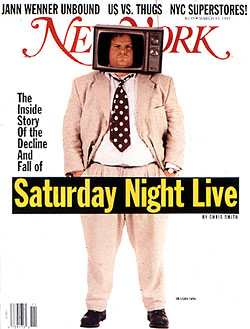 |
From the March 13, 1995 issue of New York Magazine.
It’s Friday night at Saturday Night Live, and rehearsal looks like it will drag into Monday. Wedged into one corner of the legendary Studio 8H, where Toscanini made gorgeous music and Dan Aykroyd made cheeseburgers, is the jolly bulk of guest host George Foreman.
Foreman is rehearsing his role as Uncle Joe, a shy wedding guest who is being tormented by Kevin Nealon, playing the wedding reception’s smarmy emcee. Nealon goads the reluctant Foreman into making a toast. Nealon wheedles the recalcitrant Foreman into singing a song. Nealon suggests that the annoyed Foreman toss the bouquet. Foreman threatens to slug Nealon. The five-minute sketch isn’t particularly complicated—or particularly funny. Yet after an hour of rehearsal, Nealon is still stumbling over his lines. Then Nealon, in his record ninth season at SNL, accidentally steps in front of Foreman, blocking the camera and stalling yet another take. There’s a metallic clatter as a stagehand knocks lighting poles to the floor. Five actors, fifteen extras, and four musicians sit silently, waiting for the disembodied voice of Dave Wilson, the show’s director for most of its two-decade run, to give them instructions. Potbellied technicians jam chocolate-chip cookies into their mouths. A couple of SNL writers, waiting for “Uncle Joe” to finish so they can rehearse their own bit, snicker that the sketch should be renamed “Uncle Slow.” Adam Sandler tries to cut the boredom, warbling “sing, sing a song…” in his trademark idiot-boy voice. At first, there are a few laughs. When Sandler continues into the third verse of the Carpenters song, and then the fourth, people start inspecting their shoelaces.
Standing in the darkness just beyond the set lights is a glum Janeane Garofalo. As SNL tried to rebuild from its disastrous 1993–’94 season, hiring the smart, sarcastic 30-year-old comic actress seemed perfect. Besides being funny—she is widely beloved from HBO’s Larry Sanders Show and became something of a generational mini-icon in the movie Reality Bites—Garofalo added two qualities in short supply at SNL: She’s hip and she’s female.
Right now, though, Garofalo looks like a forlorn child trapped at her parents’ dinner party. Barely over five feet tall, her lank hair pulled in three directions by pink and yellow baby-doll barrettes, Garofalo droops under the weight of her oversize plaid shirt-jacket, baggy homegirl jeans, and Doc Martens boots. Garofalo watched SNL as a kid (she was in fourth grade when it premiered), and after she signed on last summer, she called it a dream come true. Now her mood is as black as her fingernail polish.
For the first three months of the season, Garofalo’s largely been stuck in dull, secondary wife and girlfriend roles. In “Uncle Joe,” she’s a waitress, with a single line near the end of the sketch, and the scene keeps breaking down before reaching her cue.
Finally, it’s time for Garofalo to walk up to Foreman, tray of fake cocktails in hand. “Uncle Joe, just sing a song. Okay? Denise’s getting upset,” Garofalo says perkily. Two or three more takes and she’s done. She dashes off to her dressing room.
Upstairs, in the pink-walled cubicle that belonged to Gilda Radner, Garofalo shakes one Marlboro out of a fresh carton and tries to describe how she’s been treated on the show. “It’s almost like hazing,” she says. “Fraternity hazing. It’s hard. It takes its toll on you. But I think you come out much better in the end. If nothing else, this experience has just toughened me up.”
That’s diplomatic—especially since Garofalo has told friends that Saturday Night has been “the most miserable experience of my life.” What’s gotten her through it?
“Cigarettes and Stoli,” she says with a tight smile.
Later, a close friend who visited Garofalo in her hotel room after the Foreman show—the Los Angeles transplant never bothered to get an apartment in New York City—says the smoking and drinking didn’t work: “You know how depressed she is? She’s in her bed right now, just lying there. She’s absolutely destroyed as a person. The show has beaten the shit out of her.” Sure Saturday Night Live is bad these days. Everyone from Judge Ito (“hasn’t been funny in ten years”) to original and recently deceased SNL writer Michael O’Donoghue (“It couldn’t suck worse if it had rubber lips”) says so.
None of the outside critics, however, has pinpointed why—why the show that two decades ago revolutionized TV comedy continues to fall on its face. Four weeks spent recently at SNL offered up a rare portrait of institutional decay—the gargantuan exertion of sweat, blood, fried food, and bluff self-denial that yields, for example, a mind-bendingly awful sketch about space aliens and rectal probes.